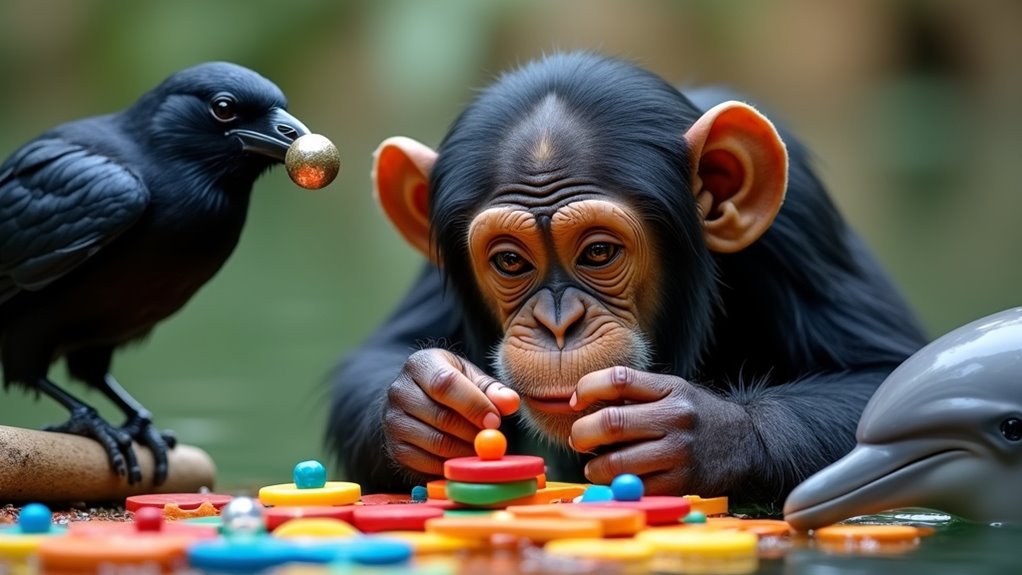You might be surprised to learn how animals like dolphins display intelligence through complex communication, problem-solving, and social skills. Dolphins use sophisticated clicks and whistles to share information, recognize themselves in mirrors, and even use tools like sponges for foraging. Their ability to adapt sounds and behaviors based on context shows remarkable cognitive abilities. Exploring these signs reveals just how aware and socially advanced some species are—there’s much more to uncover if you keep exploring.
Key Takeaways
- Many species, like dolphins, use sophisticated vocalizations and body language to communicate complex information.
- Self-awareness, demonstrated through mirror recognition, is a rare sign of high intelligence in animals.
- Tool use, such as dolphins using sponges, indicates advanced problem-solving and learning capabilities.
- Complex social behaviors and emotional intelligence reflect significant cognitive abilities in various species.
- Adaptive communication and cultural transmission showcase animals’ capacity for social learning and environmental awareness.

Have you ever wondered how smart animals really are? It’s a fascinating question, and scientists continue to uncover surprising signs of intelligence across different species. For example, dolphins are renowned for their complex communication skills. They don’t just make random sounds; instead, they use a sophisticated system of clicks, whistles, and body language to share information with one another. These vocalizations aren’t just noise—they often serve specific purposes, like coordinating hunts or alerting others to danger. Some researchers believe that dolphin communication might even include elements of social learning and cultural transmission, indicating a level of intelligence that rivals some primates. Watching dolphins interact, you can see how their ability to convey nuanced messages suggests they’re far more aware of their social environment than we might have thought. Their communication skills are a clear sign of advanced cognitive abilities, especially given how they adapt their sounds based on context and audience. Additionally, high contrast and contrast ratios in visual signals can enhance their communication effectiveness in murky or complex environments. The ability to learn and modify behaviors based on social cues further demonstrates their adaptive intelligence. Moreover, dolphins have been observed using tools, such as sponges, to protect their noses while foraging on the ocean floor, which is another indication of their problem-solving capacity and learning and innovation. Studies also suggest that dolphins can recognize themselves in mirrors, further highlighting their self-awareness and cognitive complexity. This self-recognition ability is a rare trait that underscores their advanced social cognition and emotional intelligence.
Frequently Asked Questions
Can Animals Recognize Themselves in Mirrors?
You might wonder if animals can recognize themselves in mirrors. Some species, like primates, dolphins, and elephants, show mirror recognition, indicating self-awareness. They may use the mirror to examine themselves or investigate their reflection. However, many animals don’t pass this test. Recognizing oneself in a mirror is a sign of higher cognitive ability, and your observations can reveal surprising levels of intelligence in different species.
Do Animals Use Tools Intentionally?
You might wonder if animals use tools intentionally. Evidence shows that tool use evolution varies widely across species, highlighting animal cognition diversity. Some animals, like chimpanzees and crows, deliberately select and modify objects to solve problems, demonstrating intentionality. This behavior reflects advanced cognitive abilities and helps us understand how tool use evolved. Recognizing these signs of intentional tool use deepens our appreciation for animal intelligence and their problem-solving skills.
How Do Animals Communicate Complex Ideas?
You might wonder how animals communicate complex ideas. They use vocal communication, like calls or songs, to share information, emotions, or warnings. Additionally, they rely on body language—gestures, posture, or facial expressions—to convey nuanced messages. By combining these methods, animals effectively express sophisticated thoughts and feelings, often coordinating activities or alerting others to dangers, demonstrating impressive cognitive abilities beyond simple instinct.
Can Animals Learn New Skills Quickly?
You might be surprised, but animals can learn new skills surprisingly quickly. Their learning speed varies by species, but many adapt through skill transfer, applying what they’ve learned in one context to another. For example, a bird that masters a new song can often transfer that skill to other tunes. Your observation shows animals are more capable of rapid learning than you might think, demonstrating impressive adaptability and intelligence.
Are There Species With Advanced Problem-Solving Abilities?
You might be amazed to learn that some species have truly astonishing problem-solving abilities, surpassing even your wildest expectations. These species showcase remarkable cognitive evolution, with skills that rival humans in many ways. When you compare different animals, you realize how advanced their problem-solving skills are, revealing fascinating insights into species comparisons. Their intelligence challenges your assumptions and highlights the extraordinary diversity of problem-solving talents across the animal kingdom.
Conclusion
So, next time you doubt a squirrel’s cleverness or underestimate a dolphin’s problem-solving skills, remember they’re smarter than you think. It’s ironic how we often dismiss other species’ intelligence, yet they constantly surprise us with their abilities. Perhaps, in trying to prove our dominance, we forget that true smarts come in many shapes and sizes—sometimes, they’re just hiding behind a squirrel’s quick dash or a dolphin’s playful wink.










